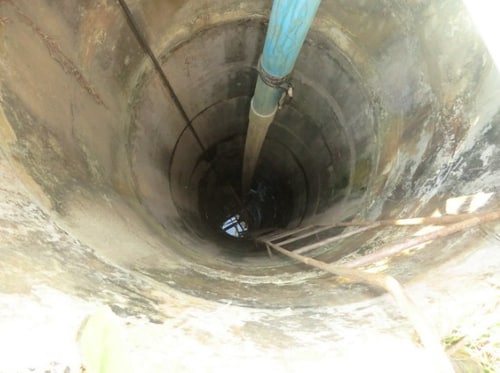A residential well generally replenishes at a rate of 5 gallons per minute. It means that a 600-gallon well will replenish in about 2 hours. A 300-gallon will take an hour to replenish, and a 900-gallon well will take 3 hours to replenish.
This rate is the estimated national average. Some users mention that their well replenishes at 25 gallons per minute. Some may replenish at 1 gallon per minute or even lower. Some water wells in Sahara in Africa can replenish with more than 1000 gallons per minute.
What Factors Affect Well Water Replenishment Rate?
Well Depth

Well depth means how deep your well is. The average is 100-500 feet, but some wells may have 25 feet depth (shallow wells), and some may be as deep as 1000 feet.
A deep well has more space and takes longer to refill than a shallow one. On the flip side, a shallow well gets filled with sediment sooner than a deep well. Hence, this also reduces the recovery rate.
Well Casing Condition
Well casing starts to deteriorate, crack or break over time. Such damages not only allow water to escape from the well but also allow sediment, sand, and rocks to enter your well, reducing your well’s replenishment rate.
Damaged Well Screen
The well screen prevents sediment, rocks, and sand from entering your well. Cracks in this screen won’t stop these elements from entering your well, making it difficult for groundwater to reach it. This will result in a slower replenishment rate and less water available.
Damaged Well Cap
A broken well cap will not prevent leaves, dirt, sand, silt, and small animals from finding their way into the well. When settled at the bottom, theses elements can reduce the rate at which water enters your well.
Faulty Well Pump
A faulty well pump can also reduce the rate at which you get water. A damaged pump will supply less water even if your well’s replenishment rate is perfect. Most well contractors check the well pump first when fixing replenishment rate problems.
Malfunctioning Pitless Adapters
Water wells in cold regions often face freezing problems. A pitless adapter is used to prevent frost in water. If you live in an area where the temperature drops below freezing point, there is a high chance that the pitless adapter is not working properly. The water may freeze inside the well.
Aquifer Health
The amount of water the aquifer holds impacts the recovery rate. Moreover, how deep your well taps the aquifer also impacts the replenishment rate. The amount and type of sediment, silt, and rocks in the aquifer also impact the rate at which water comes out.
How many wells are drawing water from the same aquifer impacts your well’s replenishment rate.
Moreover, the permeability rate (the rate at which the aquifer allows water to pass through) is also critical in deciding the recovery rate.
Environmental Factors
Environmental factors like rainfall, drought, nearby streams, lakes, or rivers, and temperature also impact the replenishing rate.
How to Improve Well Replenishment Rate (Recovery Rate)?
- Water Conservation: Reduce your water usage.
- Well Inspection: Well contractors use cameras to inspect damaged casing and broken or clogged screens. Checking the well pump, piping, and pressure tank are also part of the well inspection.
- Hydrofracking: Using a high-pressure stream of water to remove sediment and open new fractures in the aquifer.
- Well Deeping: Get your well deepened to tap more water underground.
You can read more on how to improve the well recovery rate here.
What are the signs of a well going dry?
Water Quality: A drying well’s water quality changes immediately. Your water may have more sediment, a different taste and smell, or it can be muddy. It happens because the pump draws water from the well’s bottom.
Sputtering Faucets and Reduced Flow Rate: Your faucets will sputter, and you will notice a reduced flow rate. The pump draws air along the water, resulting in coughing faucets.
Longer Pump Timing: You may notice that the pump runs longer than usual to draw water from the well.
Can a dry well fill itself?
Yes. A dry well will fill itself over time. However, the rate depends on factors like your well depth, rainfall, and water availability in the aquifer.
What to do if the well dries out and doesn’t replenish?
You can either convert to city water or modify your existing well. Structural changes like deepening your well, lowering the pump, and hydrofracking often work. The other solution is to seal this well and build a new well.
How many years before a well runs dry?
The average life of a water well is 30-50 years. Sediment buildup may force your well to dry sooner than expected.
